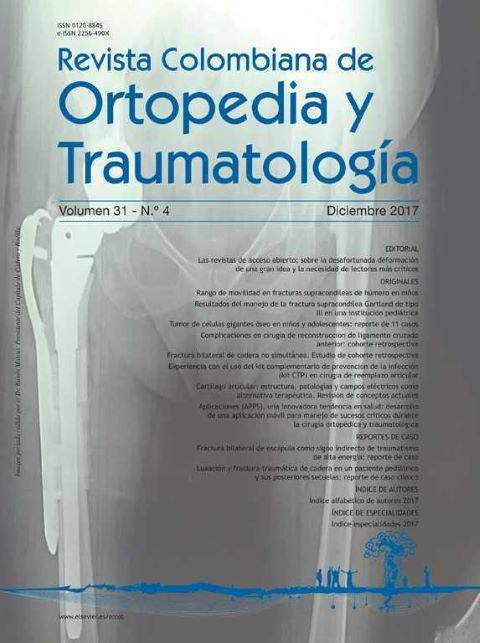Experience with the use of the complementary prevention of infection kit in joint replacement surgery
DOI:
https://doi.org/10.1016/j.rccot.2017.06.009Keywords:
arthroplasty, wound healing, sutures, occlusive dressings, haemostasisAbstract
Background: A description is presented of experience with use of the complementary prevention of infection (CTP) kit in hip and knee replacement surgery.
Materials and methods: Descriptive, retrospective, case series, study to analyse the results obtained in patients undergoing primary hip or knee replacement in the Central Military Hospital during the period between 1 July 2015 and 31 January, in which it was used the CTP kit for prevention of infection was used.
Results: A total of 22 patients were evaluated. The mean age was 61.5 years, with 20 hip replacements and 2 knee replacements performed. The mean hospital stay was 3.9 days, the mean blood loss was 106 cc. Three patients had loosening of the dressing before the removal indication (2, 2, and 9 days post-surgery), as well as a loss of adhesion of the atraumatic skin closure system at 2, 8, and 9 days. These patients were managed by managing with Micropore® to healing (20, 23, and 30 days). Satisfaction with the result of healing was much better or better than expected in 18 patients, and much worse than expected in 3 patients. There were no infections, haematomas, or other complications.
Discussion: The use of the kit in this series showed little bleeding, no discharge, or infection, and excellent satisfaction in most patients. This kit is a good strategy to help minimise the risks associated with hip and knee arthroplasty, and to increase satisfaction with the outcome of patients.
Evidence level. IV
Downloads
References
Yu S, Garvin KL, Healy WL, Pellegrini VD Jr, Iorio R. Preventing hospital readmissions and limiting the complications associated with total joint arthroplasty. J Am Acad Orthop Surg. 2015;23:e60-71. https://doi.org/10.5435/JAAOS-D-15-00044
Hemming K, Pinkney T, Futaba K, Pennant M, Morton DG, Lilford RJ. A systematic review of systematic reviews and panoramic meta-analysis: Staples versus sutures for surgical procedures. PLoS One. 2013;8:e75132. https://doi.org/10.1371/journal.pone.0075132
Steinitz D, Harvey EJ, Leighton RK, Petrie DP. Is homologous blood transfusion a risk factor for infection after hip replacement? Can J Surg. 2001;44:355-8.
Baek S-H. Identification and preoperative optimization of risk factors to prevent periprosthetic joint infection. World J Orthop. 2014;5:362-7. https://doi.org/10.5312/wjo.v5.i3.362
Innerhofer P, Klingler A, Klimmer C, Fries D, Nussbaumer W. Risk for postoperative infection after transfusion of white blood cell-filtered allogeneic or autologous blood components in orthopedic patients undergoing primary arthroplasty. Transfusion. 2005;45:103-10. https://doi.org/10.1111/j.1537-2995.2005.04149.x
Bantayehu S, Hardean EA, Jeffrey L. Management of surgical hemostasis: Topical Agents Vascular. 2008;16:S22-8.
Tsai DM, Caterson EJ. Current preventive measures for healthcare associated surgical site infections: a review. Patient Saf Surg. 2014;8:42. https://doi.org/10.1186/s13037-014-0042-5
Schuren J, Becker A, Sibbald RG. A liquid film-forming acrylate for peri-wound protection: A systematic review and metaanalysis (3 M Cavilon no-sting barrier film). Int Wound J. 2005;2:230-8. https://doi.org/10.1111/j.1742-4801.2005.00131.x
Williams C. 3 M Cavilon No Sting Barrier Film in the protection of vulnerable skin. Int Wound J. 2005;2:230-8. https://doi.org/10.1111/j.1742-4801.2005.00131.x
Campbell K, Woodbury MG, Whittle H, Labate T, Hoskin A. A clinical evaluation of 3 M no sting barrier film. Ostomy Wound Manage. 2000;46:24-30.
De Maria E. New skin closure system facilitates wound healing after cardiovascular implantable electronic device surgery. World J Clin Cases. 2015;3:675-7. https://doi.org/10.12998/wjcc.v3.i8.675
Al-Mubarak L, Al-Haddab M. Cutaneous wound closure materials: An overview and update. J Cutan Aesthet Surg. 2013;6:178-88. https://doi.org/10.4103/0974-2077.123395
Khan RJK, Fick D, Yao F, Tang K, Hurworth M, Nivbrant B, et al. A comparison of three methods of wound closure following arthroplasty. A prospective, randomised, controlled trial. J Bone Joint Surg Br. 2006:238-42, 88-B. https://doi.org/10.1302/0301-620X.88B2.16923
Smith TO, Sexton D, Mann C, Donell S. Sutures versus staples for skin closure in orthopaedic surgery: meta-analysis. BMJ. 2010;340:c1199. https://doi.org/10.1136/bmj.c1199
Livesey C, Wylde V, Descamps S, Estela CM, Bannister GC, Learmonth ID, et al. Skin closure after total hip replacement. A randomised controlled trial of skin adhesive versus surgical staples. J Bone Joint Surg Br. 2009:725-9, 91-B. https://doi.org/10.1302/0301-620X.91B6.21831
Onuminya JE, Alufohai E, Onuminya DS. Outcome of surgical zipper technique. J Nat Med Assoc. 2006;98:83.
Gorsulowsky DC, Talmor G. A novel noninvasive wound closure device as the final layer in skin closure. Dermatol Surg. 2015;41:987-9. https://doi.org/10.1097/DSS.0000000000000399
Chowdhry M, Chen AF. Wound dressings for primary and revision total joint arthroplasty. Ann Transl Med. 2015;3:268.
Fletcher N, Sofianos D, Berkes MB, Obremskey WT. Current concepts review prevention of perioperative infection. J Bone Joint Surg Am. 2007;89:1605-18. https://doi.org/10.2106/00004623-200707000-00027
Hutchinson JJ, McGuckin M, Occlusive dressings: A. microbiologic clinical review. Am F J. Infect Control. 1990;18:257-68. https://doi.org/10.1016/0196-6553(90)90167-Q
Lionelli GT, Lawrence WT. Wound dressings. Surg Clin North Am. 2003;83:617-38. https://doi.org/10.1016/S0039-6109(02)00192-5
Heller S, Rezapoor M, Parvizi J. Managing periprosthetic Joint Infection. Minimizing the risk of infection. A peri-operative Checklist. Bone Joint J. 2016:18-22, 98-B:1 Suppl A. https://doi.org/10.1302/0301-620X.98B1.36365
Benskin LLL. PolyMem® Wic® Silver® Rope: A multifunctional dressing for decreasing pain, swelling, and inflammation. Adv Wound Care. 2012;1:44-7. https://doi.org/10.1089/wound.2011.0285
Schonauer C, Tessitore E, Barbagallo G, Albanese V, Moraci A. Use of local agents: bone wax, gelatin, collagen, oxidized cellulose for hemostasis. Eur Spine J. 2004;13 Suppl. 1: S89-96. https://doi.org/10.1007/s00586-004-0727-z
Downloads
Published
How to Cite
Issue
Section
License
Copyright (c) 2024 Revista Colombiana de ortopedia y traumatología

This work is licensed under a Creative Commons Attribution 3.0 Unported License.




